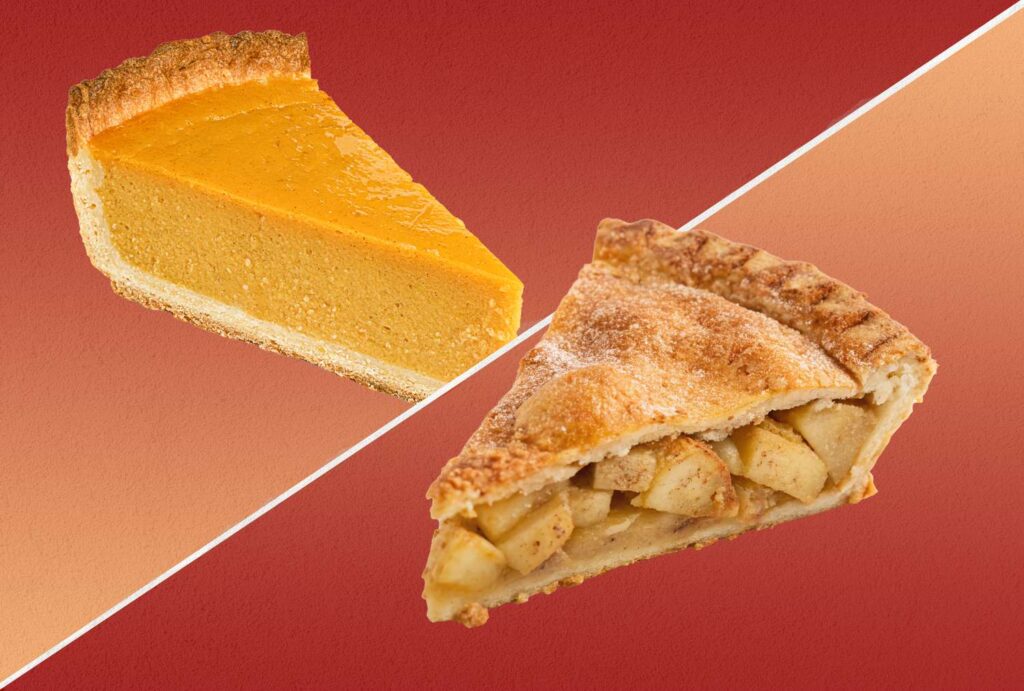- Apple pie and pumpkin pie are likely to have the same impact on blood sugar.
- While their carbs and fiber are similar, apple pie has less sugar and pumpkin pie has more protein.
- To enjoy the holiday foods you love and keep blood sugar in check, stick with small servings.
Picture this: Thanksgiving dinner is over, and now it’s time for dessert. There are two classic pies on the table, apple and pumpkin. Which one do you choose if you’re watching your blood sugar? There’s no single “right” answer, as each has its nutritional pros and cons. But when you put them head-to-head for their impact on blood sugar, we’re calling it a tie.
Of course, a lot depends on the size of your slice of pie and the other ingredients that went into it. To dig into the nitty-gritty, we compared the USDA’s nutrition stats for a standard 5.4-ounce slice of apple pie and pumpkin pie.
Here’s what we found—and why you can enjoy either of these pies in moderation as part of fall and winter celebrations. Read on to learn the details, plus expert strategies to keep your blood sugar in check this holiday season.
Why Apple and Pumpkin Pies Are Equally Healthy for Blood Sugar
They Have Roughly the Same Amount of Carbs
If you’re watching your blood sugar, you may be watching your carbs, too. While the average slice of pumpkin pie has about 55 grams of total carbs, the typical apple pie slice has roughly 56 grams.,
That said, depending on the recipe, that number can vary. “Canned pumpkin is a bit lower in carbs than an equal amount of sliced apples,” points out Anne Danahy, M.S., RDN. However, when combined with pie crust, added sugars and other ingredients, they come out approximately equal—likely having a similar effect on blood sugar.,
Apple Pie May Have Fewer Sugars
Added sugars are well known for spiking blood sugar. While the USDA doesn’t spell out added sugars in each of these pies, they do list total sugars. Apple pie has a bit of an edge with 24 grams of sugar per slice compared to pumpkin pie’s 37 grams.
Why the difference? Pumpkin’s slightly bitter flavor may need more sweetening up than apples. That doesn’t mean you can’t enjoy some pumpkin pie. Just try a slightly smaller slice. And if you’re making your own pie, Danahy recommends using about one-third less sugar than a recipe calls for. “You probably won’t notice the difference in either recipe,” she says.
They Have Equal Amounts of Fiber
Fiber is the unsung hero of blood sugar management. “Fiber helps to offset blood sugar spikes by slowing digestion and delaying the release of glucose into the bloodstream,” says Sheri Gaw, RDN, CDCES. That’s good news for lovers of both apple and pumpkin pie. A slice of either provides roughly 3 grams of fiber.
You can add even more fiber to either pie with several tasty additions. Try using nuts or seeds as a crunchy topping, swapping whole-wheat flour for some of the white flour in the crust, or adding flaxseed or chia seeds to your filling. Or, top off your pie with pomegranate seeds for a festive, fiber-rich finish.
Pumpkin Pie Has Slightly More Protein
Though the differences in protein between pumpkin and apple pie aren’t terribly dramatic, pumpkin pie edges out apple pie with 7 grams of protein per slice, compared to apple pie’s 4 grams. This has less to do with the pumpkin and apples themselves and more to do with the added ingredients. “Most pumpkin pie recipes call for eggs and dairy, such as milk, cream or evaporated milk,” says Danahy. Pumpkin pie’s extra protein may help slow down the rate at which glucose enters your bloodstream, she adds.
Healthy Blood Sugar Tips
At Thanksgiving dinner and throughout the holidays, try these tips to keep your blood sugar steady.
- Go for a walk after eating: “Gather the family and go for a walk after dinner,” Danahy suggests. “Research shows that 30 minutes of walking after a meal can lower blood sugar.”
- Add a source of fiber, protein and healthy fat: These nutrients are known for slowing the absorption of sugar into the bloodstream. Think whole grains, fruits and veggies for fiber, turkey breast for lean protein, and olives and nuts for healthy fats.
- Eat regularly throughout the day: Especially before a feast like Thanksgiving dinner, skipping meals might seem like a good strategy. But Danahy says it could backfire on your blood sugar. She recommends eating a healthy breakfast and a light lunch or snack so you’re not starving by the time dinner is served.
- Skip the sugary extras: If you’re in charge of holiday desserts, why not skip the caramel drizzle or crown of streusel? It’s an easy way to cut down on added sugars. And your guests probably won’t even notice the difference.
- Keep an eye on portions: The holidays only come once a year, so it would be a shame to miss out on your favorite foods. Whether it’s pie, stuffing or sweet potato casserole, the trick to enjoying your seasonal favorites healthfully is keeping servings small.
Our Expert Take
For most of us, Thanksgiving wouldn’t be the same without a slice of apple or pumpkin pie. If you’re wondering which one is better for your blood sugar, the answer is, it’s a tie. Apple pie and pumpkin pie both contain roughly the same amount of carbs and fiber. While apple pie is slightly lower in sugar, pumpkin pie has a little more protein. Which should you choose? “My advice is to eat the dessert you love best,” says Danahy. “Just wait 15 to 20 minutes after finishing your Thanksgiving dinner before diving into dessert. You’ll feel fuller, and chances are, you’ll be satisfied with just a few bites.” Then dig in and give thanks for both these classic desserts!

